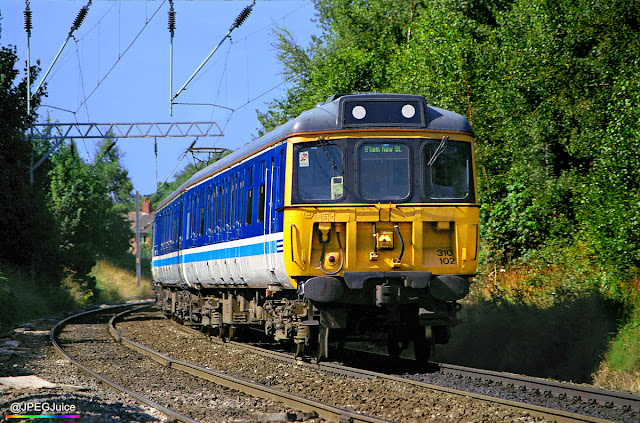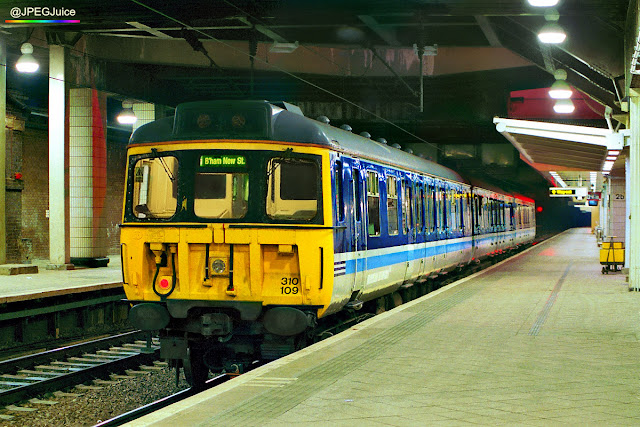"If the 310s had a last-minute claim to fame in the West Midlands, it was that they brought down the curtain on slam-door operation within the Central Trains fleet."

310113 off duty at Wolverhampton on 8th July 1999.
Many of today’s most nostalgically-appealing diesel and electric types attracted little attention in their time, and they certainly didn’t inhabit the “celebrity” category. One of the surprises I’ve had in the course of posting on Twitter, has been the reaction to images of Class 310s. These clanking sparkies may not have turned many heads as they ebbed away their final year with Central Trains, but they definitely don’t go short of applause twenty years on.
In this post I’m summarising the final year the Class 310s spent with Central Trains – working out of New Street station, where they’d been an everyday sight since their introduction by British Rail nearly three and a half decades earlier.

310112 and 310107 at rest after a Sunday duty at New Street station on 26th September 1999.
The 310s had been known by Birmingham rail enthusiasts as “Oh-Units”, and sometimes, later on in their timeline, “Dinosaurs”.
“Oh-Unit” came from the fleet numbering in the 1970s, which had completely omitted the class prefix. All examples had fleet numbers beginning with a zero, or “oh”. For example, 310046 was just numbered 046, continuing on from 045, which was the last of the Class 304s. So technically, both 304s and 310s were “Oh-Units”. However, the 304s were known as “Dinosaur Units”, so usually, if someone cited an “Oh-Unit”, they meant a 310.
The “Dinosaur” term was subsequently used more broadly for old EMUs, and that nickname made more sense for the 310s after they gained class-prefixed fleet numbers. Another choice West Midlands nickname for slam-door electric units in their heyday was “Cans”, and late on in the type’s life, people were dubbing them “Rattlers”.

310102 at Palfrey near Bescot, on the Walsall - Birmingham route, 26th July 1999.
But whatever you wanted to call them, the 310s said goodbye to New Street in March 2000. Let's pick up the chain of events the previous year…
CLASS 310 IN 1999
By the late 1990s, all of the Class 310s remaining in the West Midlands belonged to the modified /1 subclass, and had fairly recently seen their composition reduced from four cars to three. In the first half of 1999, there were still 13 sets with Central Trains, numbered 310101 to 310113.

The home of the Central 310s - Soho depot - as it looked on Saturday 21st August 1999.
CT’s 310s were not, however, being used interchangeably with the Class 323s. There was an obvious hierarchy. The 323s were a first choice on local electrified routes, and the 310s came out when higher capacity was required – or when a 323 unexpectedly became unavailable. Rush hour services on local electrified routes were the classic hotbed of 310 activity in their final CT year.

310105 and 310102 crossing to the turnaround siding at Longbridge, in Cross City service at around 09:35 on 23rd July 1999.
Although the 310s were most commonly found on the Birmingham – Walsall route in 1999, they also saw use on lines that the 323s had been expected to fully monopolise years earlier. One example was the Cross City line, where the first service ex-Longbridge on weekday mornings was a pretty regular 310. The same unit then returned for a late afternoon / early evening run on the same route. At this time, 310s could still turn up randomly replacing 323s on all-day diagrams too.
But in the near future, the new Class 170 diesel units would enable Central Trains to decant some 323s to the routes they should have been working all along. And that would mean redundancy for the CT 310s.

Almost time up for 310109. At Birmingham New Street after the evening rush hour of 22nd March 2000.
All of Central’s 310s remained in Regional Railways livery and they were never given Central Trains branding. Whether this was actual disassociation on Central’s part, or just that the trains had such limited remaining lifespans that it wasn’t worth investing in branding transfers, I don’t know. I suspect, however, that Central were not overly keen to be identified with 30-plus-year-old slam-door trains whose operation was, to spin it positively, “full of character”. Perhaps at times even a bit disturbing for passengers who were only used to modern trains. Jolts and intermittent din from under the floor did not inspire great confidence by 1999, even if all that was perfectly normal in the 1960s.
As the 310/1s became surplus to Central’s requirements, the plan was to shift them to LTS Rail, which was already an operator of 310s. The ex-Central units would briefly be of use to LTS in the interim before the new Class 357s became available.

310108 on its travels in the summer of 1999.
The first 310/1 to move from Soho to East Ham in summer ’99 was 310103, although this example was used to keep the existing LTS 310/0 fleet going, rather than running in traffic itself. The migration gathered pace in the autumn of 1999, with 310102, 310104, 310106 and 310110 joining classmate ‘103 at LTS.
By the end of 1999, the remaining Central 310s were far less likely to turn up randomly replacing 323s in the middle of the day.
DIAGRAMMING IN 2000

310108 at Duddeston station.
Going into winter 2000, the 310/1s had just five scheduled diagrams left with Central – all except one of which were morning/evening commuter duties. Either between Birmingham and Walsall or longer distance from Brum up to Liverpool. The exception was an all-day shuttle turn starting at Wolverhampton, then ping-ponging between Stoke and Stafford all day until evening, and finally making a run down from Stafford to Rugby after dark.
Although the number of actual diagrams was modest, the concentration of services within shuttling practises meant there were no fewer than 46 separate scheduled runs per day in the week. In addition to that, the units were commonly called upon to cater for football fans at weekends.
All of the above was accomplished with a remaining fleet of just 7 Class 310/1s. Namely, 310101, 310105, 310108, 310109, 310111, 310112 and 310113. 310107 was inoperable at Wolverton by this time.

310101 was chosen to work the official "Last 310" duty for Central Trains.
The official end of Central Trains’ Class 310 service fell on Monday 27th March 2000, when 310101 worked a publicised special from New Street to Liverpool and back. However, due to subsequent stock shortages, this would not be the last use of a 310 (or even this particular 310) on the Central network.
Central’s lease ended on 31st March, and after that, the chance of seeing any of your "old friends" at Walsall reduced to nil.
SLAM-DOOR SURVIVORS
If the 310s had a last-minute claim to fame in the West Midlands, it was that they brought down the curtain on slam-door operation within the Central Trains fleet. In late March 2000 when the CT 310s made their last runs, Birmingham New Street was still an absolute haven of slam-door trains. These included the whole of Virgin West Coast, virtually all of Virgin CrossCountry, First North Western’s Class 37-hauled trains to Holyhead, and the same brand’s morning/evening Manchester commuter dailies, which were Class 309 turns.

310113 and 310106 at Soho depot on Saturday 31st July 1999.
With new diesel units such as the 170s and 175s going into service, the year 2000 was going to see off the 309s (May) and the 37s (end of year), as well as the 310s. But there would still be a long way to go before slam-door operation could be described as an insignificance.
AND THAT WAS THAT
The Class 310s now remain as a golden memory in West Midlands railway history, but for many reasons, they simply had to go.